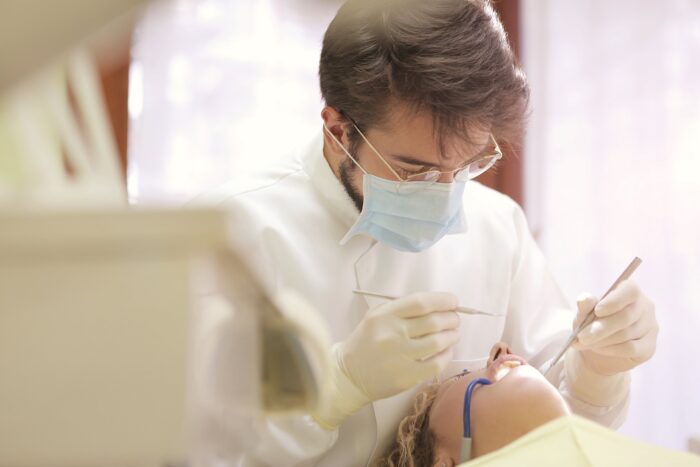Smoking Effects on Teeth and Gums
Jump To:

One of the biggest indicators that someone smokes is their oral health. We note one example in our article “What Causes Bad Breath And How To Overcome It“—it can cause unpleasant, persistent odors in your mouth. This is because cigarette smoke dries out in your mouth, leaving behind chemical components that cause that characteristic smell.
Yet that’s not the only way cigarette usage can damage your mouth. Read on to find out the details of what smoking does to your teeth and gums.
How smoking affects your teeth and gums
It deteriorates your teeth
If you smoke, your teeth don’t remain pearly white for long. A 2022 study from Clinical and Experimental Dental Research notes that tobacco products cause dental discoloration. This includes both cigarettes and e-cigarettes. Cigarette tar seeps into the cracks of your enamel, sticking there and causing a buildup of tartar and plaque. Eventually, that results in a yellowish tint in your teeth that can’t be washed away with regular brushing. In addition, dental plaque creates acid as a waste product, which can dissolve the crystals of your teeth and cause mineral loss. This can ultimately result in tooth decay.
It weakens your gums
At their best, your gums provide a steady foundation for your teeth and a strong barrier against harmful bacteria. However, a large component of cigarette smoke is carbon monoxide. This compound binds to the hemoglobin of your red blood cells and blocks oxygen from doing the same. Smoking can thus deprive your gums of oxygen and weaken their ability to fight off threats. On top of that, the tobacco in your cigarette also eats away at your gums and causes them to recede. If this keeps up long enough, the gums around your teeth will loosen, leading to tooth loss.
It increases your risk of oral ailment
Smoking can put your mouth at risk of several diseases. This includes leukoplakia (white or gray patches inside the mouth), erythroplakia (lesions on the insides of your cheeks), and oral submucous fibrosis, which you experience as a burning sensation, dryness, and restricted mouth mobility. In the worst-case scenario, smoking can cause oral cancer. Since this habit also weakens the immune system, it can even affect your ability to heal from these diseases.
How to quit smoking
To stop your mouth and gums from declining, the best thing you can do is to quit smoking altogether. However, that’s easier said than done. Here are a couple of strategies that can help.
Try nicotine replacement therapy (NRT)
NRT can help you quit smoking gradually to avoid tricky withdrawal symptoms like headaches and tremors for better cigarette cessation. Because they’re smoke- and tobacco-free, you can utilize them without further impacting your oral health.
One NRT product you can try is the nicotine pouch, which you keep between your gums and cheek for up to an hour. If you’re quitting for better oral health, you may like VELO’s nicotine pouches. These encase nicotine in fibers derived from sources like bacteria-banishing eucalyptus and anti-inflammatory pine, and their pH adjusters ensure nicotine absorption at a pH level suitable for your mouth. They’re affordable, too, starting at just $4.19 per can.
You can also try nicotine patches. These are nicotine-infused stickers you apply to a dry, hairless area of the skin and can wear throughout the day. They’re not an oral product, so they won’t affect your mouth. Nicotine patches from Nicoderm CQ are available in nicotine strengths of 7 mg, 14 mg, and 21 mg—you can start from as high of a dose as you need and slowly lessen it over time.
Leverage mindfulness
Sometimes, what helps smoking cessation is simply becoming more mindful of your desire to smoke. An APA PsycNet study found that participants who managed to increase their awareness felt less cravings, which was associated with lower levels of smoking. Engage with mindfulness practices like meditation to help you sit with your discomfort as you quit smoking.
How to boost teeth and gum recovery
While smoking negatively impacts your mouth’s interior, many of the effects are largely reversible. Try these tips to boost the health of your teeth and gums.
Clean your mouth properly
The best way to regain better oral health is to clean your mouth consistently and effectively. You’ll want to keep up the regular practice of brushing your teeth for at least 2 minutes twice a day. In doing so, be gentle and thorough with your teeth and make sure to swipe at your gum line.
For added effectiveness, consider investing in good dental equipment, too. A great toothbrush, toothpaste, and mouthwash can make all the difference in your mouth recovery. The brand Wisdom created a toothbrush specifically for current and former smokers, with extra-hard filaments to scrub away tobacco and food stains and an easy grip handle for maximum control. Use it with a fluoride toothpaste like Colgate or Sensodyne to strengthen your tooth enamel and protect against cavities.
Finally, a stellar mouthwash can help you address both the cosmetic and therapeutic aspects of oral health recovery, aiding you in controlling plaque, gingivitis, and tooth decay with regular usage. Find a brand certified with the ADA Seal of Acceptance to ensure the product’s safety and efficacy.
Get dental treatments
If you want more thorough oral care, leverage medical assistance. Your dentist can give you professional dental cleaning to clear up deposits of plaque and tartar and apply the necessary whitening treatments. They can also prescribe you other medical advice to better help your teeth recover.
Smoking is destructive to your mouth’s health. Use the tips above to quit and help your teeth and gums recover.
